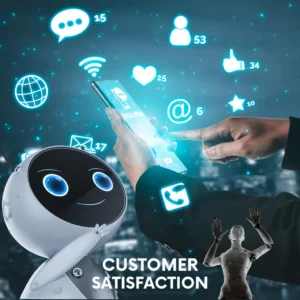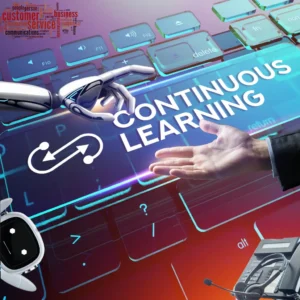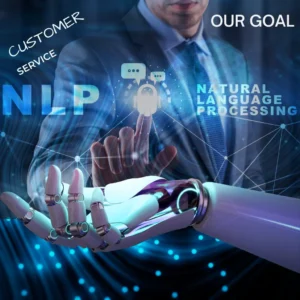
Revolutionizing Service Excellence
Unleashing the Power of Customer Service Speech Recognition and Processing Tools
Integrating advanced technologies becomes paramount for companies striving to exceed customer expectations in the ever-evolving customer service landscape.
One groundbreaking frontier is developing and implementing Customer Service Speech Recognition and Processing Tools. With a rich history in the customer service domain, our company, seasoned with 15 years of experience, is poised to embrace innovation and automation.
This discussion centres on our strategic focus on creating cutting-edge tools, including voice-based virtual assistants, sentiment analysis, automated call routing, and speech analytics.
By delving into the business, software, and hardware aspects, along with the necessary training and integrations, we aim to craft a comprehensive understanding of these transformative tools, elucidating the comparative landscape and providing insightful recommendations for their optimal utilization in our customer service operations.
Table of Contents

Arindam Roy
An Automation Consultant with 25+ years of IT Experience
5 Speech Recognition and Processing Tool ideas for the Customer Service
1. Voice-based Virtual Assistant for Phone Support:
The Customer Service Speech Recognition and Processing Tools include a cutting-edge Voice-based Virtual Assistant designed for phone support. This tool leverages Automatic Speech Recognition (ASR) technology to transcribe spoken words into text, enabling seamless interaction through voice commands. This virtual assistant enhances the customer service experience by providing a hands-free and intuitive interface, allowing customers to access information and perform tasks effortlessly.
2. Speech-to-Text Conversion for Analyzing Customer Calls:
The Speech-to-Text Conversion feature is another integral component of the Customer Service Speech Recognition and Processing Tools. This tool transforms audio data from customer calls into written text, utilizing advanced natural language understanding (NLU) techniques. By converting spoken words into text, customer interactions can be efficiently analyzed for insights, enabling businesses better to understand customer needs, concerns, and preferences.
3. Voice Sentiment Analysis for Gauging Customer Emotions:
The suite includes Voice Sentiment Analysis, a powerful tool for assessing the emotional tone in customer interactions. Using Speech Emotion Recognition, this tool evaluates the sentiments expressed during conversations. By understanding customer emotions, businesses can tailor their responses and services to enhance customer satisfaction, fostering stronger relationships and loyalty.
4. Automated Call Routing Based on Spoken Keywords:
Customer Service Speech Recognition and Processing Tools incorporate Automated Call Routing based on Spoken Keywords. This tool employs advanced speech recognition algorithms to identify specific keywords within customer conversations. By recognizing these keywords, calls are automatically routed to the appropriate departments or specialized agents, ensuring efficient and timely resolution of customer queries.
5. Speech Analytics for Quality Monitoring:
The suite includes Speech Analytics as a tool for quality monitoring in customer service. This feature analyzes recorded calls using artificial intelligence, identifying patterns, issues, and opportunities for improvement. By systematically evaluating interactions, businesses can enhance the overall quality of their customer service, identify training needs, and continually implement strategies to improve the customer experience.
In summary, the Customer Service Speech Recognition and Processing Tools offer a comprehensive solution for automating and optimizing customer service processes. From voice-based virtual assistants and speech-to-text conversion to sentiment analysis, automated call routing, and speech analytics, these tools empower businesses to stay at the forefront of the market by leveraging advanced AI technologies for enhanced customer satisfaction and operational efficiency.
Voice-based Virtual Assistant for Phone Support
Business Knowledge Required:
- Customer Service Operations: Understanding customer service workflows, common challenges, and critical touchpoints to design the virtual assistant effectively for seamless integration into existing processes.
- User Experience (UX) Design: Proficiency in UX design principles to create an intuitive and user-friendly voice-based virtual assistant, ensuring a positive customer experience during phone support interactions.
Software Knowledge Needed:
- Automatic Speech Recognition (ASR): Expertise in ASR algorithms and models to accurately transcribe spoken words into text. Familiarity with popular ASR frameworks like Google Speech Recognition or DeepSpeech.
- Natural Language Processing (NLP): Knowledge of NLP techniques to understand and interpret user commands, extract intent, and facilitate meaningful interactions. Mastery of NLP frameworks such as spaCy or NLTK.
- Voice User Interface (VUI) Design: Proficiency in designing VUIs to create effective voice-based interactions, considering factors like tone, pacing, and natural language understanding.
Hardware Needed to Run the Tools:
- Audio Processing Hardware: Adequate hardware capabilities for real-time audio processing, including high-quality microphones and audio processing units to capture and process voice inputs.
- Server Infrastructure: Scalable server infrastructure, potentially utilizing cloud services, to handle the computational demands of real-time speech recognition and processing.
Training Required to Run the Tools:
- ASR Model Training: Training data scientists or ASR specialists to fine-tune ASR models for improved accuracy, especially when dealing with industry-specific terminology or accents.
- User Training for Virtual Assistant Interactions: Comprehensive training for customer service representatives and end-users on effectively interacting with the voice-based virtual assistant, including handling common queries and troubleshooting.
Integrations Necessary:
- Call Center Systems: Seamless integration with existing call centre systems to enable smooth communication and data exchange, ensuring the virtual assistant aligns with established customer service processes.
- CRM Systems: Integration with CRM systems to access and update customer information based on voice interactions, providing a personalized customer service experience.
Comparative Tools Already Available in the Market:
- Google Cloud Speech-to-Text: A powerful and widely used ASR service that can transcribe spoken words accurately.
- Amazon Lex: Offers a comprehensive platform for building conversational interfaces with built-in ASR and NLP capabilities.
Recommendation:
Considering the customer service domain’s specialized requirements and the need for seamless integration, it is recommended that a reputable speech recognition framework (such as Google Cloud Speech-to-Text or Amazon Lex) be bought and customized according to specific business needs. This approach combines the advantages of a proven technology foundation with the flexibility to tailor the solution for the customer service domain.
Cost/Benefits Analysis on the Recommendation:
- Costs:
- Licensing and Subscription Fees: Incurred costs for purchasing the base speech recognition framework and any ongoing subscription fees.
- Customization Costs: Initial development costs for customizing the tool to align with specific customer service requirements.
- Benefits:
- Faster Implementation: Rapid deployment using an existing framework reduces the time-to-market for the voice-based virtual assistant.
- Proven Technology: Leveraging established speech recognition frameworks ensures reliability and accuracy in transcription.
- Cost Savings: Lower development costs than building from scratch while allowing for necessary customizations.
In conclusion, a recommendation to buy and customize a reputable speech recognition framework strikes a balance between leveraging proven technology and tailoring the solution to the unique needs of the Customer Service Speech Recognition and Processing Tools in the customer service domain.
Speech-to-text conversion for analyzing customer calls
Business Knowledge Required:
- Customer Service Operations: Understanding the customer service domain, including common issues, jargon, and communication patterns, ensures the speech-to-text conversion tool accurately captures relevant information.
- Data Privacy and Compliance: Knowledge of data privacy regulations and compliance requirements to ensure the tool adheres to industry standards, especially when handling sensitive customer information.
Software Knowledge Needed:
- Automatic Speech Recognition (ASR): Proficiency in ASR algorithms to accurately convert spoken words into text. Familiarity with ASR frameworks such as Google Speech-to-Text or CMU Sphinx.
- Natural Language Understanding (NLU): Expertise in NLU techniques to analyze and interpret the transcribed text, extracting meaningful insights from customer calls. Knowledge of NLU frameworks like spaCy or Stanford NLP.
- Data Preprocessing and Cleaning: Skills in data preprocessing and cleaning to enhance speech-to-text conversion accuracy, addressing background noise and variations in audio quality.
Hardware Needed to Run the Tools:
- Audio Processing Hardware: Adequate hardware capabilities for real-time audio processing, including quality microphones and audio processing units to capture and process voice inputs.
- Server Infrastructure: Scalable server infrastructure, possibly using cloud services, to handle the computational demands of real-time speech-to-text conversion, especially during peak call times.
Training Required to Run the Tools:
- ASR Model Fine-tuning: Training data scientists or ASR specialists to fine-tune the ASR model for specific accents, language variations, and industry-specific terminology.
- NLU Model Training: Training NLU specialists to optimize the NLU model for accurately understanding and extracting relevant information from transcribed text.
Integrations Necessary:
- Call Center Systems: Integration with existing call centre systems to seamlessly capture and convert audio from customer calls, linking the tool with customer interaction databases.
- Analytics Platforms: Integration with analytics platforms for further analysis of the transcribed text, enabling data-driven insights for customer service improvements.
Comparative Tools Already Available in the Market:
- IBM Watson Speech to Text: Offers accurate speech-to-text conversion with the ability to process real-time streaming audio.
- Microsoft Azure Speech Service: Provides a comprehensive speech recognition service with transcription and speaker identification features.
Recommendation:
Given the availability of mature and reliable speech-to-text conversion services in the market, it is recommended that you buy and customize an existing solution. This approach combines the benefits of proven technology with the flexibility to tailor the tool to specific business needs within the Customer Service Speech Recognition and Processing Tools.
Cost/Benefits Analysis on the Recommendation:
- Costs:
- Licensing Fees: Incurred costs for purchasing a subscription or licensing the chosen speech-to-text service.
- Customization Costs: Initial development costs for customizing the tool to align with specific customer service requirements.
- Benefits:
- Rapid Deployment: Faster implementation by leveraging an existing, well-established speech-to-text service.
- Reliability: Utilizing a recognized service ensures reliability and accuracy in transcribing customer calls.
- Cost Savings: Lower development costs than building from scratch while allowing for necessary customizations.
In conclusion, a recommendation to buy and customize an existing speech-to-text service strikes a balance between leveraging proven technology and tailoring the solution to the unique needs of the Customer Service Speech Recognition and Processing Tools in the customer service domain.
Voice Sentiment Analysis for Gauging Customer Emotions
Business Knowledge Required:
- Customer Service Understanding: A deep understanding of customer service interactions, including familiar emotional cues, tones, and expressions specific to the industry.
- Emotional Intelligence: Expertise in emotional intelligence to accurately gauge and interpret customer emotions in spoken language, considering cultural nuances and contextual variations.
Software Knowledge Needed:
- Speech Emotion Recognition (SER) Algorithms: Proficiency in SER algorithms, such as deep learning models or feature-based methods, to accurately identify and classify emotional tones in speech.
- Natural Language Processing (NLP): Knowledge of NLP techniques to enhance the interpretation of emotional content, ensuring a nuanced understanding of spoken words beyond surface-level sentiments.
- Machine Learning (ML): Expertise in ML techniques for training and fine-tuning models to recognize a wide range of emotional states and variations in customer interactions.
Hardware Needed to Run the Tools:
- Audio Processing Hardware: Adequate hardware capabilities for real-time audio processing, including quality microphones and audio processing units to capture and analyze voice inputs.
- Server Infrastructure: Scalable server infrastructure, potentially utilizing cloud services, to handle the computational demands of real-time emotion recognition, especially during peak customer interaction times.
Training Required to Run the Tools:
- Model Training: Training data scientists or ML specialists to train and fine-tune the SER model on diverse datasets, ensuring it can recognize a broad spectrum of emotional tones accurately.
- Annotation Training for Quality Control: Training annotators to ensure the accuracy of the training dataset by labelling emotional cues in spoken language, supporting model training and validation.
Integrations Necessary:
- Call Center Systems: Integration with call centre systems to capture and analyze customer footprint in real-time, providing immediate insights into emotional dynamics.
- CRM Systems: Integration with CRM systems to link emotional analysis with customer profiles, enabling a personalized and empathetic response from customer service representatives.
Comparative Tools Already Available in the Market:
- Affectiva: A comprehensive emotion AI platform that includes speech emotion recognition to understand customer emotions.
- Beyond Verbal: Offers a vocal biomarker platform, including emotion analytics, to assess and interpret emotions through speech.
Recommendation:
Given the complexity of emotion recognition and the availability of specialized tools in the market, it is recommended that an existing emotion analysis platform be bought and customized. This approach enables the utilization of established providers’ expertise while tailoring speech recognition and processing tools to the specific needs of the customer service industry.
Cost/Benefits Analysis on the Recommendation:
- Costs:
- Licensing Fees: Incurred costs for purchasing a subscription or licensing the chosen emotion analysis platform.
- Customization Costs: Initial development costs for customizing the tool to align with specific customer service requirements.
- Benefits:
- Specialized Expertise: Leveraging the specialized expertise of established emotion analysis platforms ensures accurate and nuanced emotion recognition.
- Time and Resource Savings: Faster implementation and reduced resource requirements compared to building a solution from scratch.
- Continuous Updates: Access to constant updates and improvements from the platform provider, ensuring the tool stays current with advancements in emotion recognition technology.
In conclusion, the recommendation to buy and customize an existing emotion analysis platform balances efficiency, accuracy, and customization within the context of Speech Recognition and Processing Tools for customer service in the industry.
Automated Call Routing Based on Spoken Keywords
Business Knowledge Required:
- Call Center Operations: In-depth knowledge of call centre workflows, including the typical customer queries, departments, and issues, to effectively design an automated call routing system based on spoken keywords.
- Industry-Specific Terminology: Familiarity with industry-specific terminology and keywords relevant to customer service to ensure accurate recognition and routing of calls.
Software Knowledge Needed:
- Speech Recognition Algorithms: Expertise in speech recognition algorithms capable of accurately identifying and extracting keywords from spoken language. Familiarity with ASR frameworks like Google Speech-to-Text or CMU Sphinx.
- Natural Language Processing (NLP): Knowledge of NLP techniques to interpret the context around spoken keywords, enabling a nuanced understanding of customer queries and needs.
- Machine Learning (ML): Proficiency in ML models for training and optimizing the system to recognize new keywords and adapt to changing patterns in customer interactions.
Hardware Needed to Run the Tools:
- Audio Processing Hardware: Adequate hardware capabilities for real-time audio processing, including quality microphones and audio processing units to capture and analyze voice inputs.
- Server Infrastructure: Scalable server infrastructure, potentially utilizing cloud services, to handle the computational demands of real-time speech recognition and keyword analysis, especially during peak call times.
Training Required to Run the Tools:
- Model Training: Training data scientists or ML specialists to fine-tune the speech recognition and NLP models, ensuring optimal performance in identifying and processing spoken keywords.
- Keyword Database Maintenance: Establishing processes for regularly updating the keyword database to incorporate new terms or changes in industry language, ensuring the system stays accurate and relevant.
Integrations Necessary:
- Call Center Systems: Seamless integration with existing call centre systems to route calls based on identified keywords, linking the tool with customer interaction databases.
- CRM Systems: Integration with CRM systems to align automated call routing with customer profiles, enabling a personalized and efficient customer service experience.
Comparative Tools Already Available in the Market:
- Twilio IVR: A programmable conversational AI platform for building automated call routing systems, including natural language understanding.
- Cisco Unified Contact Center Express: A comprehensive solution with automated call distribution based on various parameters, including spoken keywords.
Recommendation:
Given the complexity of automated call routing and the availability of specialized tools in the market, it is recommended that you buy and customize an existing conversational AI platform. This approach allows for leveraging the tools of established providers while tailoring the tool to the specific needs of the customer service industry within the speech recognition and processing tools.
Cost/Benefits Analysis on the Recommendation:
- Costs:
- Licensing Fees: Incurred costs for purchasing a subscription or licensing the chosen conversational AI platform.
- Customization Costs: Initial development costs for customizing the tool to align with specific customer service requirements.
- Benefits:
- Specialized Expertise: Leveraging the specialized expertise of established conversational AI platforms ensures efficient and accurate automated call routing.
- Time and Resource Savings: Faster implementation and reduced resource requirements compared to building a solution from scratch.
- Continuous Updates: Access to constant updates and improvements from the platform provider, ensuring the tool stays current with speech recognition and processing technology advancements.
In conclusion, the recommendation to buy and customize an existing conversational AI platform strikes a balance between efficiency, accuracy, and customization within the context of Speech Recognition and Processing Tools for customer service in the industry.
Speech analytics for quality monitoring
Business Knowledge Required:
- Quality Assurance Processes: A thorough understanding of quality assurance processes within the customer service domain, including key performance indicators (KPIs), metrics, and criteria for evaluating call quality.
- Customer Interaction Patterns: The design of the speech analytics tool will be informed by knowledge of common customer interaction patterns, issues, and opportunities for improvement.
Software Knowledge Needed:
- Speech Analytics Algorithms: Expertise in implementing speech analytics algorithms utilizing AI and machine learning techniques to analyze recorded calls, detect patterns, and identify areas for improvement.
- Natural Language Processing (NLP): Proficiency in NLP techniques to extract meaningful insights from transcribed speech, allowing for a nuanced understanding of customer interactions.
- Data Analytics and Visualization: Skills in data analytics and visualization tools to effectively present actionable insights from the analyzed call data.
Hardware Needed to Run the Tools:
- Data Storage Infrastructure: Sufficient storage infrastructure to store and manage large volumes of recorded calls for analysis.
- Server Infrastructure: Scalable server infrastructure, potentially utilizing cloud services, to handle the computational demands of real-time speech analytics and data processing.
Training Required to Run the Tools:
- Model Training: Training data scientists or ML specialists to fine-tune the speech analytics models, ensuring they effectively identify patterns and issues within recorded calls.
- User Training for Interpretation: Training quality assurance teams or relevant personnel on interpreting and acting upon the insights provided by the speech analytics tool.
Integrations Necessary:
- Call Recording Systems: Integration with call recording systems to access and analyze recorded calls, extracting valuable data for quality monitoring.
- CRM Systems: Integration with CRM systems to align the insights gained from speech analytics with customer profiles and service history.
Comparative Tools Already Available in the Market:
- Verint Speech Analytics: Offers a comprehensive speech analytics solution with AI capabilities for identifying trends, sentiments, and areas for improvement in customer interactions.
- Nice Systems: Provides speech analytics tools with compliance monitoring, quality assurance, and agent performance evaluation features.
Recommendation:
Given the complexity of speech analytics and the availability of specialized tools in the market, it is recommended that you buy and customize an existing speech analytics solution. This approach allows you to leverage the tools of established providers while tailoring the tool to the specific needs of the customer service industry within the Speech Recognition and Processing Tools.
Cost/Benefits Analysis on the Recommendation:
- Costs:
- Licensing Fees: Incurred costs for purchasing a subscription or licensing the chosen speech analytics platform.
- Customization Costs: Initial development costs for customizing the tool to align with specific quality monitoring requirements.
- Benefits:
- Specialized Expertise: Leveraging the specialized expertise of established speech analytics platforms ensures efficient and accurate quality monitoring.
- Time and Resource Savings: Faster implementation and reduced resource requirements compared to building a solution from scratch.
- Continuous Updates: Access to constant updates and improvements from the platform provider, ensuring the tool stays current with advancements in speech analytics technology.
In conclusion, the recommendation to buy and customize an existing speech analytics platform strikes a balance between efficiency, accuracy, and customization within the context of the industry’s Speech Recognition and Processing Tools for customer service.
Conclusion
In conclusion, the development and implementation of Customer Service Speech Recognition and Processing Tools present a pivotal leap forward in enhancing efficiency, accuracy, and customer satisfaction within the customer service domain. As companies seek to automate processes and stay at the forefront of technological advancements, these tools offer tailored solutions to the intricate challenges of speech recognition, sentiment analysis, automated call routing, and quality monitoring. The requisite business knowledge spans understanding call centre operations, customer behaviour, and industry-specific language nuances, ensuring these tools are finely tuned to the unique requirements of the customer service landscape.
The depth of software knowledge necessary, covering speech recognition algorithms, natural language processing, and machine learning, underscores the sophistication required for effective tool development. Leveraging existing platforms, complemented by customization, emerges as a pragmatic recommendation, balancing proven technology with the flexibility to address specific business needs. The comparative tools available in the market, such as those offered by industry leaders like Google and Amazon and specialized providers like Verint and Nice Systems, showcase the versatility and competitiveness of the landscape.
Moreover, the benefits of implementing Customer Service Speech Recognition and Processing Tools extend beyond operational efficiency, encompassing improved customer interactions, personalized services, and real-time insights for proactive decision-making. While costs involve licensing fees and customization expenses, the long-term advantages of time savings, continuous updates, and access to specialized expertise position these tools as indispensable assets for companies aspiring to revolutionize their customer service capabilities. In embracing these innovative tools, organizations are poised to set new standards for excellence in customer service, driving sustained growth and customer loyalty in an increasingly dynamic business environment.
Related Articles
- 50 AI Tools for the Customer Services Domain
- 5 Facial Recognition and Emotion Analysis Tools of Customer Service
- 5 Customer Service Predictive Analytics and Recommendation
- 5 Customer Service Tolls for Automation and RPA
- 5 Customer Service Natural Language Processing (NLP) Tools
- 5 Customer Service Tools for Knowledge Management
- 5 Customer Service Tools for Continuous Learning and Improvement
- 5 Customer Service Tools for Customer Survey Analysis
- 5 Customer Service Tools for Social Media Monitoring
- 5 Customer Service Tools for Data Security and Privacy





















